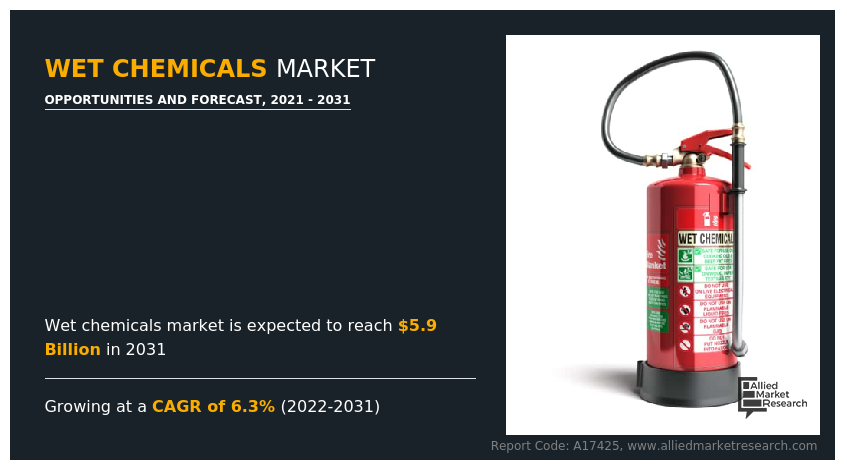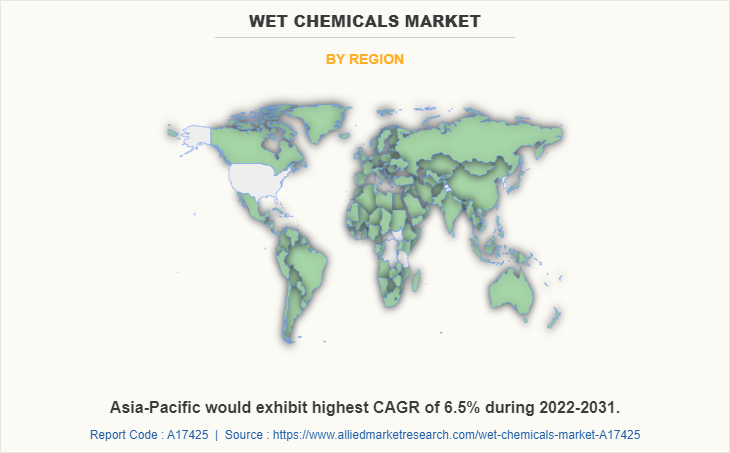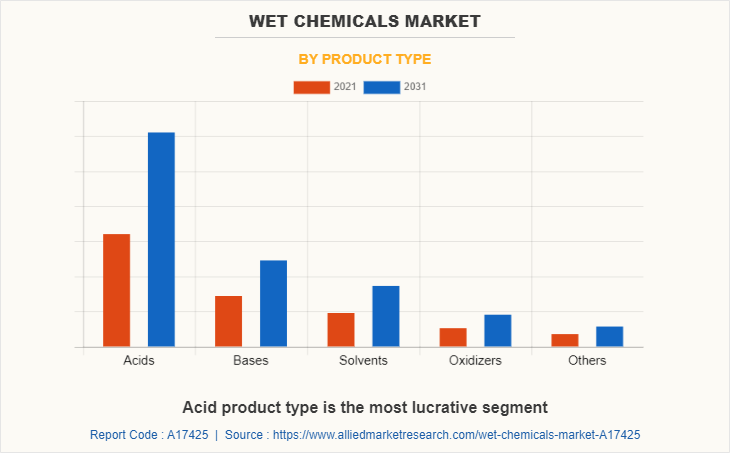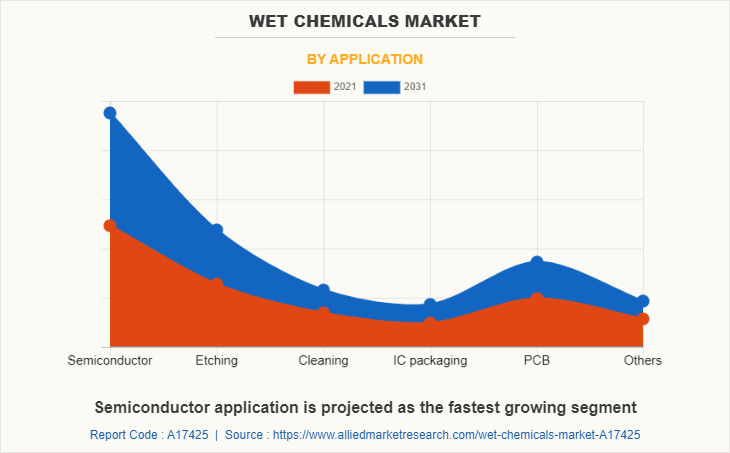Wet Chemicals Market Outlook - 2031
The global wet chemicals market size was valued at $3.2 billion in 2021, and is projected to reach $5.9 billion by 2031, growing at a CAGR of 6.3% from 2022 to 2031. Rise in adoption of wet chemicals in pharmaceutical production is a significant factor driving the market demand, as these chemicals are essential in the formulation, synthesis, and cleaning processes in the industry. Wet chemicals are used for tasks such as purifying active pharmaceutical ingredients (APIs), sterilizing equipment, and maintaining cleanroom environments, ensuring high levels of precision and contamination control.

Introduction
Wet chemicals refer to a broad category of liquid chemicals used in various industrial processes, particularly in the cleaning, etching, and treatment of surfaces, as well as in the production and fabrication of materials. These chemicals are typically applied in the form of aqueous or solvent-based solutions, often used in conjunction with physical or chemical reactions to achieve desired results on surfaces, substrates, or during manufacturing. Wet chemicals are especially prominent in industries such as semiconductors, electronics, pharmaceuticals, and photovoltaics, where precision in surface treatment is critical.
In the semiconductor industry, wet chemicals are essential for the cleaning and etching of wafers during the manufacturing process. These chemicals can remove photoresist layers, unwanted particles, and oxides, ensuring the high purity and functionality required for microelectronic components.
Key Market Dynamics
Wet chemicals are commercial organic and inorganic chemicals used in various end-use industries. It acts as an etching and cleaning agent in semiconductors processing systems. In addition, wet chemical-based acids, bases, solvents, oxidizer, and other chemicals form have a wide range of applications in agriculture, textile, electronics, and others. Increasing global population, growing demand for electric vehicles, and increasing purchasing power of consumers have led them to seek electronics components and electric vehicles. For instance, according to an article published by India Brand Equity Foundation in May 2022, overall electric vehicle reached a global share of 8.3% (including battery electric vehicles [BEVs] and Plug-in hybrid electric vehicles [PHEVs]) in 2021 from 4.2% in 2020, with 6.75 million vehicles on the road. This is an increase of 108% as of 2020. The upsurge in demand for electric vehicles has enhanced the performance of wet chemicals where they are used as etching and cleaning application of semiconductor processing. All these factors enhance the overall demand for wet chemicals during the forecast period.
However, availability of alternative substitutes for harmful and toxic wet chemicals is expected to hamper the overall growth of the market. In addition, increase in raw material prices and energy costs, rising competition, and enforcement of regulations on wet chemicals are the key factors affecting the business sustainability of wet chemical manufacturers. All these factors are expected to hamper the growth of the wet chemicals market during the forecast period.
In pharmaceutical manufacturing, especially in drug formulation and synthesis, the need for ultrapure chemicals is critical to ensure the quality, efficacy, and safety of medications. Wet chemicals, including acids, bases, and solvents, are essential in various processes such as cleaning, etching, and purifying raw materials. With increasing regulatory scrutiny on product purity and the growing complexity of pharmaceutical compounds, the demand for high-purity wet chemicals is surging. All these factors are anticipated to offer new growth opportunities for the global wet chemicals market during the forecast period.
Market Segmentation
The wet chemicals market analysis is done on the basis of product type, application, and region. On the basis of product type, the market is categorized into acid, base, solvent, oxidizer, and others. On the basis of application, it is divided into semiconductor, automotive, flexographic printing, building & construction, and others. Region-wise, the market is studied across North America, Europe, Asia-Pacific, and LAMEA.

Wet Chemicals Market By Region
The Asia-Pacific wet chemicals market size is projected to grow at the highest CAGR during the forecast period, and accounted for a major wet chemicals market share in 2021, with 48% of the total share. The utilization of wet chemicals in sectors, such as semiconductors, electronics, IC packaging, and others are the major key market trends in the Asia-Pacific region. Proliferating demand for electronics products where wet chemicals are used as prime etching material fuels the market growth. Moreover, China is the topmost producer of electric vehicles and printed circuits globally where acid-based wet chemicals are widely employed in production process of proper fabrication of chips, microchips, and transistors of semiconductors. This is anticipated to propel the market growth in the Asia-Pacific market.

Wet Chemicals Market By Product Type
In 2021, the acid product type was the largest revenue generator, and is anticipated to grow at a CAGR of 6.7% during the forecast period. Acid-based wet chemicals include acetic acid, hydrogen peroxide, sulphuric acid, nitric acid, phosphoric acid, hydrofluoric acid, and others. Acid-based wet chemicals find application in semiconductors, electronics, IC packaging, and many other end-use industries. Acid-based wet chemicals act as an etching and cleansing agent in the manufacturing process of microchips in the processing system of semiconductors. This is anticipated to escalate the demand for acid-based wet chemicals in the growing semiconductor industry. Furthermore, hydrogen peroxide is an excellent source of fertilizer and pesticide, due to which it is predominantly used in the agriculture sector. This factor is expected to boost the overall demand for acid-based wet chemicals during the forecast period.

Wet Chemicals Market By Application
In 2021, the semiconductors application was the largest revenue generator, and is anticipated to grow at a CAGR of 6.8% during the forecast period. Technological advancement in the electronics industry and growing demand for electronics-based devices have driven the wet chemicals market. Wet chemicals are extensively used in etching and cleaning applications during the production and processing system of semiconductors. This is anticipated to enhance the demand for wet chemicals in semiconductors applications. Furthermore, the recent commercialization of nano-based devices has boosted the market potential for etching chemicals. In response to this, the growing usage of semiconductors and integrated chips in the manufacturing of electrical components has driven the electronic wet chemicals market during the forecast period. The rising demand for semiconductors in LCD and LED sets has escalated the demand for wet chemicals.
Competitive Landscape
The global wet chemicals market profiles leading players that include BASF SE, Chang Chun Group, Dow, Eastman Chemical Company, Evonik Industries, Formosa Daikin Advanced Chemicals Co. Ltd., Honeywell International Inc., Hubei Xingfa Chemicals Group Co. Ltd., Kanto Kagaku, Mitsubishi Electric Corporation, Rin Kagaku Kogyo Co. Ltd., Santoku Chemical Industries Co. Ltd., Solvay Inc., Yingpeng Chemical Co. Ltd., and Zhejiang Kaisn Fluorochemical Co. Ltd. The global wet chemicals market report provides in-depth competitive analysis as well as profiles of these major players.
Key Benefits For Stakeholders
- This report provides a quantitative analysis of the market segments, current trends, estimations, and dynamics of the wet chemicals market analysis from 2021 to 2031 to identify the prevailing wet chemicals market opportunities.
- The market research is offered along with information related to key drivers, restraints, and opportunities.
- Porter's five forces analysis highlights the potency of buyers and suppliers to enable stakeholders make profit-oriented business decisions and strengthen their supplier-buyer network.
- In-depth analysis of the wet chemicals market segmentation assists to determine the prevailing market opportunities.
- Major countries in each region are mapped according to their revenue contribution to the global market.
- Market player positioning facilitates benchmarking and provides a clear understanding of the present position of the market players.
- The report includes the analysis of the regional as well as global wet chemicals market trends, key players, market segments, application areas, and market growth strategies.
Wet Chemicals Market Report Highlights
| Aspects | Details |
| Market Size By 2031 | USD 5.9 billion |
| Growth Rate | CAGR of 6.3% |
| Forecast period | 2021 - 2031 |
| Report Pages | 310 |
| By Product type |
|
| By Application |
|
| By Region |
|
| Key Market Players | Mitsubishi Electric Corporation, Honeywell International Inc., Eastman Chemical Company, Evonik Industries, Rin Kagaku Kogyo Co. Ltd., BASF SE, Dow, Solvay Inc., Zhejiang Kaisn Fluorochemical Co. Ltd., Hubei Xingfa Chemicals Group Co. Ltd., Chang Chun Group, Yingpeng Chemical Co. Ltd., Formosa Daikin Advanced Chemicals Co. Ltd., KANTO KAGAKU, Santoku Chemical Industries Co. Ltd. |
Analyst Review
According to CXOs of leading companies, the global wet chemicals market is expected to exhibit high growth potential. Wet chemicals are commercial chemicals, including sulfuric acid, hydrogen peroxide, nitric acid, and others. Wet chemicals are extensively used in the semiconductor and electronics industry as etching and cleaning agent. In addition, it also finds application in agrochemicals, chemical, and industrial sectors. In addition, rising demand for various electronics components such as LCD, LED, gadgets, bulb, electronic devices, and others from the electronics industry is expected to surge the demand for wet chemicals in upcoming years. The CXOs further added that sustained economic growth and the development of the electronics and semiconductors sector have surged the popularity of wet chemicals
Rise in demand for high-purity wet chemicals for etching printed circuit boards and silicon wafer production has escalated the demand for wet chemicals during the forecast period. Several acids and base wet chemicals are used as the etching agent. For instance, hydrogen peroxide is one of the cost-effective etching agent, extensively used in semiconductors and electronics processing applications. These are the upcoming trends of wet chemicals market in the world
Semiconductor is the leading application of wet chemicals market
Asia-Pacific is the largest regional market for wet chemicals
The global wet chemicals market forecast was valued at $3.2 billion in 2021, and is projected to reach $5.9 billion by 2031, growing at a CAGR of 6.3% from 2022 to 2031
BASF SE, Dow, Eastman Chemical Company, Evonik Industries, Formosa Daikin Advanced Chemicals Co. Ltd., and Honeywell International Inc. are the top companies to hold the market share in wet chemicals
Loading Table Of Content...



